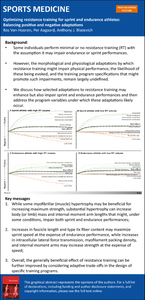Sports Medicine ( IF 9.3 ) Pub Date : 2024-10-07 , DOI: 10.1007/s40279-024-02110-4 Bas Van Hooren, Per Aagaard, Anthony J. Blazevich

|
Resistance training (RT) triggers diverse morphological and physiological adaptations that are broadly considered beneficial for performance enhancement as well as injury risk reduction. Some athletes and coaches therefore engage in, or prescribe, substantial amounts of RT under the assumption that continued increments in maximal strength capacity and/or muscle mass will lead to improved sports performance. In contrast, others employ minimal or no RT under the assumption that RT may impair endurance or sprint performances. However, the morphological and physiological adaptations by which RT might impair physical performance, the likelihood of these being evoked, and the training program specifications that might promote such impairments, remain largely undefined. Here, we discuss how selected adaptations to RT may enhance or impair speed and endurance performances while also addressing the RT program variables under which these adaptations are likely to occur. Specifically, we argue that while some myofibrillar (muscle) hypertrophy can be beneficial for increasing maximum strength, substantial hypertrophy can lead to macro- and microscopic adaptations such as increases in body (or limb) mass and internal moment arms that might, under some conditions, impair both sprint and endurance performances. Further, we discuss how changes in muscle architecture, fiber typology, microscopic muscle structure, and intra- and intermuscular coordination with RT may maximize speed at the expense of endurance, or maximize strength at the expense of speed. The beneficial effect of RT for sprint and endurance sports can be further improved by considering the adaptive trade-offs and practical implications discussed in this review.
Graphical abstract
中文翻译:

优化短跑和耐力运动员的阻力训练:平衡积极和消极的适应
阻力训练 (RT) 触发不同的形态和生理适应,这些适应被广泛认为有利于提高表现和降低受伤风险。因此,一些运动员和教练进行或开具大量 RT 的假设是,最大力量能力和/或肌肉质量的持续增加将导致运动表现的改善。相比之下,其他人在 RT 可能会损害耐力或冲刺表现的情况下,使用最少或不使用 RT。然而,RT 可能损害身体机能的形态和生理适应、诱发这些适应的可能性以及可能促进此类损伤的训练计划规范在很大程度上仍未定义。在这里,我们讨论了对 RT 的选定适应如何增强或损害速度和耐力表现,同时也解决了可能发生这些适应的 RT 程序变量。具体来说,我们认为,虽然一些肌原纤维(肌肉)肥大有利于增加最大力量,但实质性肥大会导致宏观和微观适应,例如身体(或肢体)质量和内部力矩臂的增加,在某些情况下,这可能会损害短跑和耐力表现。此外,我们讨论了肌肉结构、纤维类型、微观肌肉结构以及与 RT 的肌肉内和肌肉间协调的变化如何以牺牲耐力为代价最大限度地提高速度,或以牺牲速度为代价最大限度地提高力量。通过考虑本综述中讨论的适应性权衡和实际意义,可以进一步改善 RT 对短跑和耐力运动的有益影响。






























 京公网安备 11010802027423号
京公网安备 11010802027423号